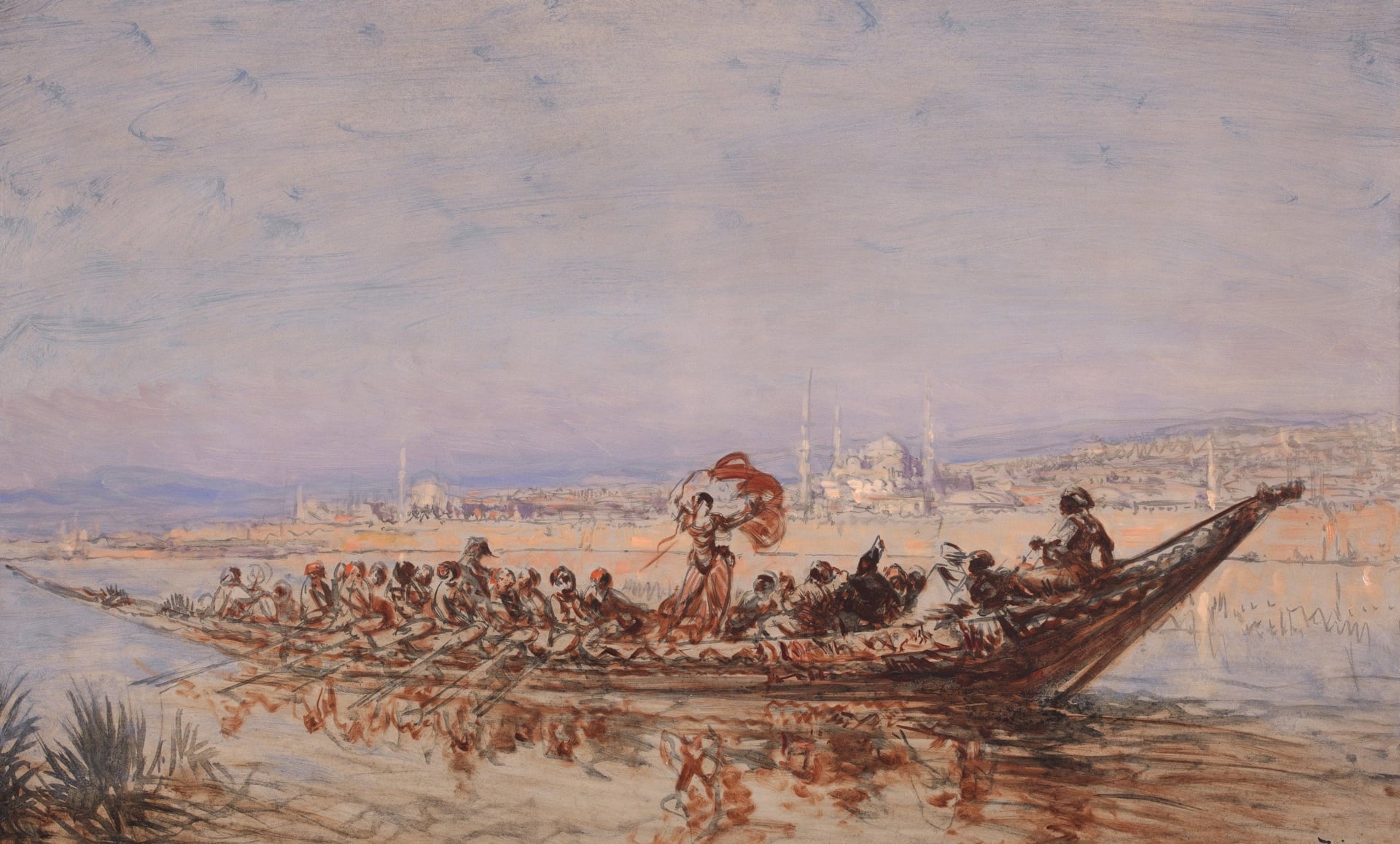08 December 2016
Pera Museum presents an exhibition of French artist Félix Ziem, one of the most original landscape painters of the 19th century. The exhibition Wanderer on the Sea of Light presents Ziem as an artist who left his mark on 19th century painting and who is mostly known for his paintings of Istanbul and Venice, where the city and the sea are intertwined. Through the exhibition, we will be sharing detailed information about the artworks. This week we are sharing Ziem’s work inspired by Istanbul and “the East”!

Dancer in a Caique, 1870 - 1880, Oil on wood, 69 x 113 cm., Musée Ziem Collection
Félix Ziem had long been dreaming of traveling to Istanbul but his plans were suspended due to the Crimean War. Finally, in mid-July of 1856, three months after the signing of the peace treaty that ended the conflict (The Treaty of Paris, 30 March 1856), he boarded the boat from Marseille. He arrived at the shores of the Bosphorus on July 18th for a two-month stay.
Ziem traversed İstanbul by himself; he wandered into its old winding streets, blended into the crowd, and immersed himself in the world of fishermen and markets. He filled his sketchbooks with costumes, characters, cars drawn by large oxen, dogs, boats, and caiques. Pavilions, fountains, mosques –most notably the silhouettes of Süleymaniye and Yeni Cami– served as his sources of inspiration. In order to emphasize the refineries of their architecture, Ziem only depicted these buildings from the outside.

Constantinople, Sunset over the Bosphorus, 1870 - 1880, Pen and brown ink on paper, 10 x 13 cm., Musée Ziem Collection
On August 13th, he was on the wooden bridge in Karaköy to witness the Kurban Bayramı (Eid al-Adha) ceremonies. On that day, much like every year, Sultan Abdülmecid I left his Dolmabahçe Palace on the Bosphorus to go, by boat, to Topkapı Palace and from there to Sultan Ahmed Mosque to attend prayer. Ziem took this opportunity to depict the ostentatious imperial caiques roaming the glittery waters of the Bosphorus.
Despite the summer heat, Ziem was fascinated by Istanbul, a city in which the effects of light, water, and color were everywhere. He was especially interested in the subtle relationship between the various bodies comprised by the sky, the sea, and the architecture, as well as the interpenetration of land and water. This particular configuration, which served as the source of a unique brightness, he also found in Venice and Martigues.
 Ziem stayed in Istanbul until September 18th, whereupon he left for Egypt via Izmir, Rhodes, and Beirut. He was in Alexandria on October 8, 1856. He went down the Nile until Thebes, visited Aswan and Philae before returning to France after stops in Greece and Sicily.
Ziem stayed in Istanbul until September 18th, whereupon he left for Egypt via Izmir, Rhodes, and Beirut. He was in Alexandria on October 8, 1856. He went down the Nile until Thebes, visited Aswan and Philae before returning to France after stops in Greece and Sicily.
During this long journey, Ziem produced countless sketches, drawings, and studies, creating a visual memory he would be able to use for the rest of his life. However, the Orient he portrayed on his canvases was not the “real” Orient, but a pseudo-Orient, which disregarded realism and replaced it with the exaltation of light and timelessness.
Félix Ziem: Wanderer on the Sea of Light exhibition took place at Pera Museum between 10 November 2016 and 29 January 2017.

French artist Félix Ziem is one of the most original landscape painters of the 19thcentury. The exhibition Wanderer on the Sea of Light presents Ziem as an artist who left his mark on 19th century painting and who is mostly known for his paintings of Istanbul and Venice, where the city and the sea are intertwined.

Félix Ziem is accepted as one of the well-known artists of the romantic landscape painting, and has been followed closely by art lovers and collectors of all periods since. He had a profound influence on generations of artists after him, and was the first artist whose works were acquired by the Louvre while he was still alive.
Tuesday - Saturday 10:00 - 19:00
Friday 10:00 - 22:00
Sunday 12:00 - 18:00
The museum is closed on Mondays.
On Wednesdays, the students can
visit the museum free of admission.
Full ticket: 300 TL
Discounted: 150 TL
Groups: 200 TL (minimum 10 people)